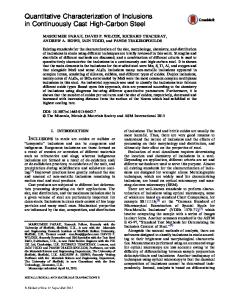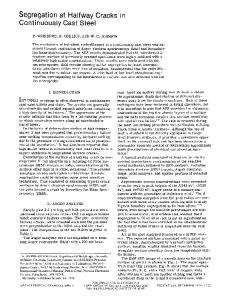Initial development of thermal and stress fields in continuously cast steel billets
- PDF / 1,332,957 Bytes
- 14 Pages / 594 x 774 pts Page_size
- 30 Downloads / 298 Views
I.
INTRODUCTION
CONTINUOUS casting now accounts for over 50 pct of domestic steel production in the United States and over 90 pct of the steel production in Japan. The conversion to continuous casting from ingot casting has been driven by the improved yield, thermal efficiency, and higher quality available in the newer process. To help achieve these gains, the process has been mathematically modeled to increase the understanding of the roles of important variables in the process, improve design of continuous casting machines, and eliminate casting defects. The defects to which continuously cast billets are susceptible include longitudinal and transverse surface cracks and subsurface cracks. Although the specifics depend on both the defect and the casting system, their primary cause is the interaction between heat transfer in the mold and the solidification and concomitant shrinkage of the billet. Over the years, many mathematical models have been developed to help determine the origin of, and assess means for controlling, these defects. The aspect of the problem which makes building a mathematical model for the heat transfer difficult is that the effective heat transfer between the billet and the mold is largely determined by the size of the air gap between them, caused by the thermal distortion of both the billet and the mold. Because the size of the gap depends on the respective temperature distributions, the formulations for the problems of air gap formation and temperature are coupled. To overcome this problem, a number of researchers have estimated values for the heat transfer coefficients. It is common practice to divide the billet into two or more heat transfer zones. The upper zone has a high heat transfer coefficient to characterize the good thermal contact between the billet and the mold, perhaps mediated by a mold lubricant or flux. The lower region of the mold is characterized
J.E. KELLY and T. G. O'CONNOR, Graduate Students, and B.G. THOMAS, Assistant Professor, and J.A. DANTZIG, Associate Professor, are with the Department of Mechamcal and Industrial Engineering, University of Illinois at Urbana-Champaign, 1206 West Green Street, Urbana, IL 61801. K. P. MICHALEK, formerly Graduate Student, Department of Mechanical and Industrial Engineering, University of Illinois at Urbana-Champaign, is with AT&T, Room 20505, 200 Laurel Avenue, Middletown, NJ 07748. Manuscript submitted March 11, 1987.
METALLURGICALTRANSACTIONS A
by smaller heat transfer coefficients, associated with the air gap. The magnitude and locations of these regions vary from author to author, t~'zl based on experimental observations and/or educated guesses. A second popular means for determining the heat transfer characteristics is to analyze experimental data gathered in plant trials, t3'41Typically, thermocouples or pairs of thermocouples are placed in the mold at various locations and their response is used to determine the temperature distribution in the mold and, in particular, to compute the heat flux on the inside face of the mol
Data Loading...











